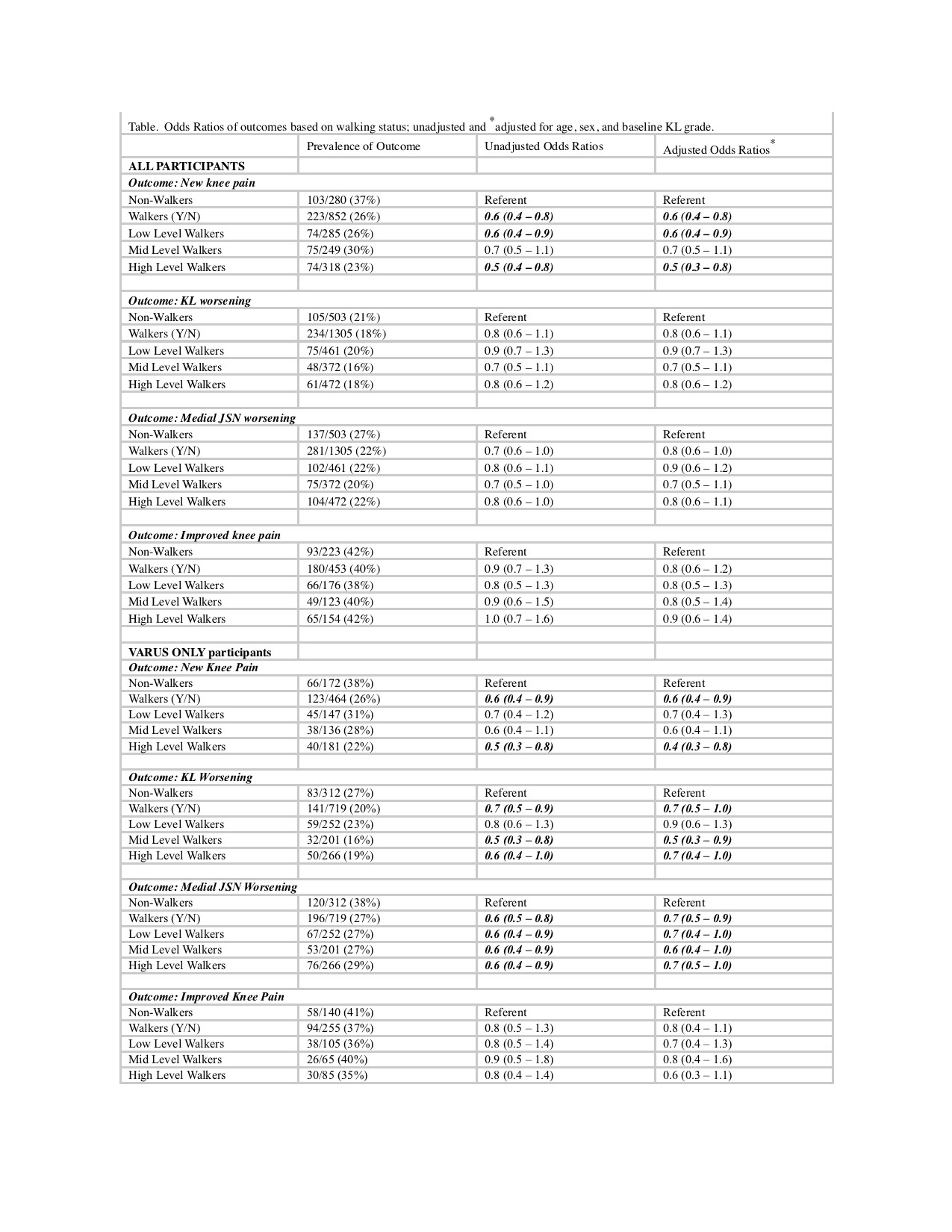Session Information
Session Type: Poster Session D
Session Time: 9:00AM-11:00AM
Background/Purpose: Walking for exercise is recommended for knee osteoarthritis (OA) management though benefits have not been demonstrated in epidemiologic studies. We aimed to assess the relationship between walking for exercise and symptom or structure progression in those with knee OA.
Methods: This was a nested cohort study within the Osteoarthritis Initiative (OAI) of those > 50 years old with radiographic OA (ROA) at baseline. A modified version of the Historical Physical Activity Survey Instrument was used to assess walking for exercise during ages > 50 years old, dichotomously and with 4 levels of walking, including the referent group, those who did not walk for exercise. At baseline and 48-month visits, participants were assessed for frequent knee pain and Kellgren-Lawrence (KL) grade and medial joint space narrowing (JSN) on posterior-anterior semi-flexed knee radiographs. ROA was defined as KL ≥ 2. Outcomes were: 1) New knee pain – frequent knee pain absent at baseline but present at 48 months (only including those without frequent knee pain at baseline), 2) KL worsening – increase in KL grade, 3) Medial JSN worsening – increase in medial JSN score, and 4) Improved knee pain – frequent knee pain present at baseline but absent at 48 months (only including those with frequent knee pain at baseline). Participants with knee arthroplasty between baseline and 48 months were classified as having new knee pain and KL and Medial JSN worsening. Assessed on long limb films, the Hip-Knee-Ankle angles defined static alignment: 1) varus: < -2o, 2) valgus: > +2o, 3) neutral: between -2o and +2o. Including only ROA knees, we performed logistic regression using generalized estimating equations to account for correlation between knees, adjusting for age, sex, and baseline KL grade. Analyses were stratified by static alignment.
Results: Of 1203 participants, 73% walked for exercise. New knee pain was less common in those who walked (OR 0.6; 95%CI 0.4 – 0.8) (see Table). In varus knees, results were similar but also less KL (OR 0.7; 95%CI 0.5 – 1.0) and medial JSN progression (OR 0.7; 95%CI 0.5 – 0.9) was observed (See Table). Neutral and valgus analyses had insufficient numbers to calculate ORs; however in neutral knees, those who walked had more improved knee pain (47% v 39%) but no structural benefits. In valgus knees, those who walked for exercise had modestly more new knee pain (33% v. 29%), KL progression (20% v. 15%) and medial JSN worsening (9% v. 5%).
Conclusion: Walking may be disease modifying for knee OA. In individuals > 50 years old with knee OA, walking for exercise was associated with less development of frequent knee pain. There may be differential effects of walking based on static alignment. In varus knees, walking was also associated with less structural progression. These findings support that walking for exercise should be encouraged for most people with knee OA. A clinical trial to confirm these findings is warranted.
 Table 1. Odds Ratios of outcomes based on walking status; unadjusted and *adjusted for age, sex, and baseline KL grade.
Table 1. Odds Ratios of outcomes based on walking status; unadjusted and *adjusted for age, sex, and baseline KL grade.
To cite this abstract in AMA style:
Lo G, Vinod S, Harkey M, McAlindon T, Kriska A, Rockette-Wagner B, Eaton C, Hochberg M, Jackson R, Kwoh C, Nevitt M, Driban J. Walking for Exercise May Be Symptom and Structure Modifying for Those with Established OA and with Varus Alignment – Data from the Osteoarthritis Initiative [abstract]. Arthritis Rheumatol. 2020; 72 (suppl 10). https://acrabstracts.org/abstract/walking-for-exercise-may-be-symptom-and-structure-modifying-for-those-with-established-oa-and-with-varus-alignment-data-from-the-osteoarthritis-initiative/. Accessed .« Back to ACR Convergence 2020
ACR Meeting Abstracts - https://acrabstracts.org/abstract/walking-for-exercise-may-be-symptom-and-structure-modifying-for-those-with-established-oa-and-with-varus-alignment-data-from-the-osteoarthritis-initiative/
